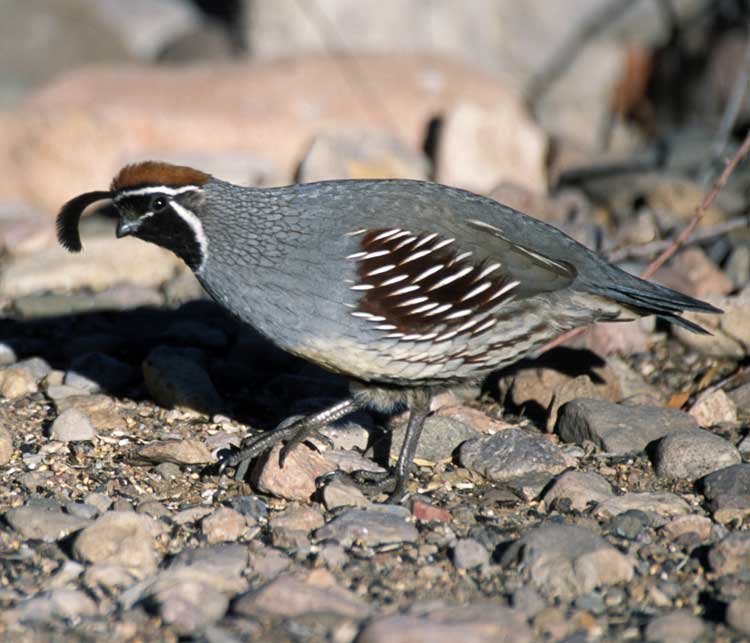
Callipepla gambelii (*)
Superregnum: Eukaryota
Cladus: Unikonta
Cladus: Opisthokonta
Cladus: Holozoa
Regnum: Animalia
Subregnum: Eumetazoa
Cladus: Bilateria
Cladus: Nephrozoa
Superphylum: Deuterostomia
Phylum: Chordata
Subphylum: Vertebrata
Infraphylum: Gnathostomata
Megaclassis: Osteichthyes
Cladus: Sarcopterygii
Cladus: Rhipidistia
Cladus: Tetrapodomorpha
Cladus: Eotetrapodiformes
Cladus: Elpistostegalia
Superclassis: Tetrapoda
Cladus: Reptiliomorpha
Cladus: Amniota
Classis: Reptilia
Cladus: Eureptilia
Cladus: Romeriida
Subclassis: Diapsida
Cladus: Sauria
Infraclassis: Archosauromorpha
Cladus: Crurotarsi
Divisio: Archosauria
Cladus: Avemetatarsalia
Cladus: Ornithodira
Subtaxon: Dinosauromorpha
Cladus: Dinosauriformes
Cladus: Dracohors
Cladus: Dinosauria
Ordo: Saurischia
Cladus: Eusaurischia
Subordo: Theropoda
Cladus: Neotheropoda
Cladus: Averostra
Cladus: Tetanurae
Cladus: Avetheropoda
Cladus: Coelurosauria
Cladus: Tyrannoraptora
Cladus: Maniraptoromorpha
Cladus: Maniraptoriformes
Cladus: Maniraptora
Cladus: Pennaraptora
Cladus: Paraves
Cladus: Eumaniraptora
Cladus: Avialae
Infraclassis: Aves
Cladus: Euavialae
Cladus: Avebrevicauda
Cladus: Pygostylia
Cladus: Ornithothoraces
Cladus: Ornithuromorpha
Cladus: Carinatae
Parvclassis: Neornithes
Cohors: Neognathae
Cladus: Pangalloanserae
Cladus: Galloanseres
Ordo: Galliformes
Familia: Odontophoridae
Genus: Callipepla
Species: Callipepla gambelii
Name
Callipepla gambelii (Gambel, 1843)
References
Proceedings of the Academy of Natural Sciences of Philadelphia 1 p. 260
Vernacular names
čeština: křepel přílbový
dansk: Ørkentopvagtel
Deutsch: Helmwachtel
English: Gambel's Quail
español: Colín de Gambel, Codorniz chiquiri
suomi: aavikkotupsuviiriäinen
français: Colin de Gambel
magyar: Gambel-fogasfürj
italiano: Colino di Gambel
日本語: ズアカカンムリウズラ, zuakakammuriuzura
Nederlands: Gambels Kuifkwartel, Helmkwartel
norsk: Svartbukvaktel
polski: przepiór czubaty
português: Colim-de-elmo
русский: Шлемоносный хохлатый перепел
slovenčina: prepelka čelenková
svenska: Ökentofsvaktel
中文: 黑腹翎鹑
Gambel's quail (Callipepla gambelii) is a small ground-dwelling bird in the New World quail family. It inhabits the desert regions of Arizona, California, Colorado, New Mexico, Nevada, Utah, Texas, and Sonora; also New Mexico-border Chihuahua and the Colorado River region of Baja California. The Gambel's quail is named in honor of William Gambel, a 19th-century naturalist and explorer of the Southwestern United States.
The species is not as widely introduced as the related California quail. It was, however, released on San Clemente Island in 1912 by Charles T. Howland et al., where it is currently still established.[2]
Description
The Callipepla gambelii birds are easily recognized by their top knots and scaly plumage on their undersides. Gambel's quail have bluish-gray plumage on much of their bodies, and males have copper feathers on the top of their heads, black faces, and white stripes above their eyes. The bird's average length is 11 in (28 cm) with a wingspan of 14–16 in (36–41 cm). These birds have relatively short, rounded wings and long, featherless legs. Its diet consists primarily of plant matter and seeds.
Gambel's quail can be commonly confused with California quail due to similar plumage. They can usually be distinguished by range, but when this does not suffice, California quail have a more scaly appearance and the black patch on the lower breast of the male Gambel's quail is absent in the California quail. The two species are sister taxa which diverged during the Late Pliocene or Early Pleistocene, 1 to 2 mya.[3]
Taxonomy
Subspecies
There are two recognized subspecies:[4]
C. g. fulvipectus (Nelson, 1899) – fulvous-breasted quail – southeast Arizona and southwest New Mexico to southern Sonora in Mexico
C. g. gambelii (Gambel, 1843) – nominate – Utah and Nevada through Mojave Desert to Colorado, northeastern Baja California and Tiburón Island.
Behavior
Gambel's quail primarily move about by walking and can move surprisingly fast through brush and undergrowth. They are a non-migratory species and are rarely seen in flight. Any flight is usually short and explosive, with many rapid wingbeats, followed by a slow glide to the ground. In the late summer, fall, and winter, the adults and immature young congregate into coveys of many birds. In the spring, Gambel's quail pair off for mating and become very aggressive toward other pairs. The chicks are decidedly more insectivorous than adults, gradually consuming more plant matter as they mature. Gambel's quail are monogamous and rarely breed in colonies. The female typically lays 10–12 eggs in a simple scrape concealed in vegetation, often at the base of a rock or tree. Incubation lasts from 21–23 days, usually performed by the female and rarely by the male. The chicks are precocial, leaving the nest with their parents within hours of hatching.[5]
References
BirdLife International (2018). "Callipepla gambelii". IUCN Red List of Threatened Species. 2018: e.T22679609A131906681. doi:10.2305/IUCN.UK.2018-2.RLTS.T22679609A131906681.en. Retrieved 11 November 2021.
Huey 1932.
Zink & Blackwell 1998.
"Callipepla gambelii". Integrated Taxonomic Information System. Retrieved 9 February 2006.
Thomson 2001.
Sources
Huey, Laurence M. (1932). "Some Light on the Introduction of Gambel Quail on San Clemente Island, California" (PDF). Condor. Cooper Ornithological Society. 34 (1): 46. doi:10.2307/1363791. JSTOR 1363791.
Thomson, Matthew (2001). "Callipepla gambelii Gambel's quail". Animal Diversity Web. University of Michigan Museum of Zoology. Archived from the original on 2016-03-05. Retrieved 10 June 2016.
Zink, Robert M.; Blackwell, Rachelle C. (1998). "Molecular systematics of the Scaled Quail complex (genus Callipepla)" (PDF). Auk. 115 (2): 394–403. doi:10.2307/4089198. JSTOR 4089198.
Retrieved from "http://en.wikipedia.org/"
All text is available under the terms of the GNU Free Documentation License

